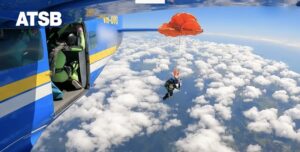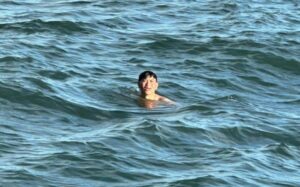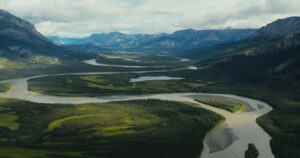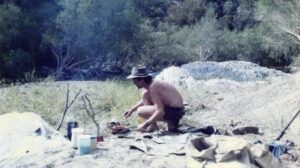Baffin Island, the fifth-largest island on Earth, is an extremely remote place, thousands of kilometres from roads or large towns. North of the Canadian mainland, it is also the largest island in the arctic archipelago, and one of the most scenic. Its east coast features huge walls that soar more than 1,000m from an ocean that freezes solidly for over half the year.

Sam Ford Fiord. Photo: Mike Libecki
Halfway up the east coast of Baffin lies the jewel of Sam Ford Fiord. Its granite cliffs are perhaps the tallest in the world. In 1995, two American climbers, Paul Gagner and Rick Lovelace, decided to scale the south face of Walker Citadel, a 1,200m monolith poised vertically over the sea ice.
Although familiar to the Inuit residents of Clyde River, about 100km away, outsiders had rarely visited Sam Ford Fiord before 1995. Its lure as a climbing mecca was just beginning to catch on. Climbers know how to climb, but they aren’t necessarily familiar with sea ice or the unique challenges of arctic big-wall climbing.

Walker Citadel in May. Photo: Jerry Kobalenko
Unscaled walls everywhere
In early June, Gagner and Lovelace flew to Clyde River. Their Inuit guide took them by snowmobile to the fiord. They camped on the other side of the fiord, opposite Walker Citadel. They saw unscaled walls everywhere. The morning after their arrival, they wanted to discuss a plan “B” with their Inuit guide, in case things went wrong at the end of the climb. They planned to trek back to civilization across the frozen ocean, leaving their heavy climbing gear in the fiord for the guide to pick up later.
But their guide had already left. For weeks, they would not be able to contact anybody from this remote place, since they did not have a satellite phone.

Qamutiks are traditional sleds pulled by snowmobiles or dog teams. In June, leads of open water have already begun to form in the deteriorating sea ice. These leads widen as the season progresses. Photo: Paul Gagner
They spent a few days in camp, studying the wall with binoculars to map out their route. They carried their equipment to the foot of the wall, which was about 1.5km away. Each time they crossed the bay, the surface of the sea ice was a little different. More and more meltwater appeared on the ice, which is typical for June. The ice was a little less than one metre thick. Tidal pressures began to form cracks in the sea ice, called leads, that expanded over time.

The climbers approach Walker Citadel. Pools of meltwater already lie on the still-firm sea ice. Photo: Paul Gagner
The climb begins
With their equipment now at the foot of the wall, they began to climb on their first day of good weather. Like many walls in Sam Ford Fiord, Walker Citadel rises directly from the ocean. There are no shoreline aprons.
Advancing up this enormous wall, they came to a gravel terrace at a height of 244m. They called it Mastodon Terrace and made it their advanced camp. Here, they camped and stored the rest of the ropes, water, food, and other gear. Once the weather improved, they could continue climbing.

Above the Mastodon Terrace on Walker Citadel. Photo: Paul Gagner
After 10 days of preparation and waiting for good weather, they continued above Mastodon Terrace. They had food for at most 14 days, the time that they had calculated for the entire route.
But they couldn’t move as quickly as they wanted. Constant storms and strong winds slowed their pace. After eight days on the wall, they were only halfway up. They were never able to climb for more than two days in a row.
At one point they noticed that the sea ice below them was beginning to break up. Under the dazzling 24-hour sun at this time of year, the ice can disappear in a very short time.
During the climb, they sheltered every night in a titanium portaledge. The wind shook their portaledge like a rag. They called it a “washing machine”.

On the portledge. Photo: Paul Gagner
Half-rations
Days turned into weeks. After 16 days, the final section of the route remained. At night, on the portaledge, they discussed the issue of thawing ice and what to do after they got down. In the end, they decided to focus on their immediate objective, which was to finish the wall.
They had already been on half-rations for 10 days. Finally, after 21 days of climbing, they reached the top and notched the first ascent of Superunknown (VII 5.10+ A3, 1,220m, 26 pitches).

During their climb, the ice melted completely, leaving nothing but open sea below them. Photo: Paul Gagner
The two-day descent was a challenge because they did not know exactly what they were going to do when they reached the bottom. Their platform of sea ice, on which they planned to walk out, had totally disappeared. Nothing remained but an icy ocean.
Plan of escape
Eventually, they devised a sort of plan. It wasn’t ideal but it was the only possible way out. Nearby was a glacier that they could access. They would have to hike west along that glacier to the bottom of Sam Ford Fiord. Then they would have to cross swollen rivers and tundra to reach the village of Clyde River. This roundabout route was about 290km on foot — a far cry from the easy 100km over firm sea ice.
They left a note by the wall outlining their plan, in case the guide came to collect their things, as they had previously agreed. They then set off. But the glacier was much bigger and more dangerous than they had imagined. They had no crampons, no rope, no ice axes.

Hungry hiking. Photo: Paul Gagner
They advanced very slowly, 12km a day. Then came icy rivers that they had to cross as well as they could. By the third night, they realized that this plan was not working.
At this rate, they would die in the middle of nowhere without food and without anyone knowing where they were. They weighed their possibilities and concluded that the best option was to return to Sam Ford Fiord.
Back to the fiord
So the next day they turned back to the uncertainty of their original predicament. But the only thing they focused on was trying to get back to the fiord alive.
After six days of hiking, three days there and three days back, they reached their camp again. Water was all around. Gagner and Lovelace took refuge in their tent and began to ration what little food they had left. They had to share a can of tuna a day, then ran out of everything. They had already missed their flight home. And the Inuit outfitter did not arrive as agreed to collect their things.
Another week passed, this time without food. “It is an effort to walk 20 feet from the tent to pee,” Paul Gagner wrote in his journal. “My mind seems detached from my body. I begin to wonder how people die from starvation. I am skinnier than Rick. It worries me that I will probably be the first to go.”
They began to have hallucinations. Death was near. The wind howled nonstop. Otherworldly noises were driving the two climbers crazy.
Divine intervention
They had been two months in the fiord, 23 days on the wall, six days of unsuccessful hiking, two weeks of half-rations, and 10 days without any food. There was nothing to do but passively accept whatever fate they were dealt. At that moment, a boat appeared in the fiord with three Inuit caribou hunters and saved them.

Inuit hunters take them back to civilization. Photo: Paul Gagner.
Their guide later told them that the ice had blocked the entrance to the fiord the day he went to collect the climbers’ things, so he could not access the fiord. Who knows why he didn’t try again? That was many years ago, and he’s out of the business now. Since then, many big-wall climbers, base jumpers, couloir skiers, and adventurers have discovered Sam Ford Fiord. At least two base jumpers have died. But no one has been trapped like that again.






